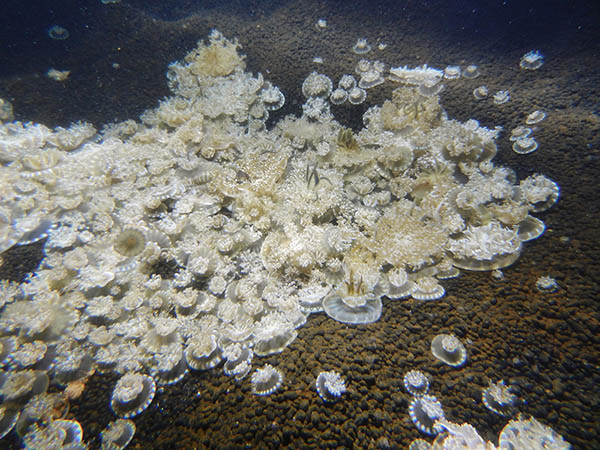 |
 |
 |
|||||
|
Invasive Jellyfish:
“Those gloves are left over from our invasive jellyfish removal,” Keli‘i explains, pointing to the washing station at the fish pond. “That’s a recent addition to our fishpond. They’re called upside-down jellyfish. They sit on the bottom. The cap, the top of the jellyfish, is facing the bottom and their tentacles are up. They’re kind of goldenrod, orangey yellow in color, two different species. Cassiopeia is the genus. We believe they drifted downwind from Moku o Lo‘e over there in the distance, because they exist over there. But the water is deep in between, so maybe it’s taken a long time for them to make it over. Or the winds had to be just right or really strong or something like that because they only started popping up last September and the population exploded to thousands probably of jellyfish. “They’ve been in Hawai‘i for several decades and they’re distributed across most islands. They’re on Moloka‘i, Kualoa Ranch’s fishpond, Moli‘i, has them and it’s actually really bad over there. Keawanui fishpond, it’s really, really bad. So last September we started seeing jellyfish pop up in the fishpond, we had some scientists help us identify them, we found out firsthand that they sting, but it’s pretty cool but weird how they sting. The tentacles don’t sting. They have a mucus on the tentacles that when disturbed, the mucus comes off of the tentacles and the stinging cells are just in the water. “You can actually touch the jellyfish and as long as you wash your hand pretty quickly, you won’t get stung because the mucus will just come right off you. I have touched the jellyfish and I’ve been totally fine. But you could walk next to a whole bunch of them, not touch one but still get stung because the mucus comes off in the water. So those gloves are leftovers from a Boy Scout Eagle Scout project. They came down, about 20 Boy Scouts organized by one Eagle Scout. They purchased gloves and waders, they got in to the fishpond and I think the final number was they pulled out 989 individual jellyfish that weighed about 1,100 pounds. “They spread them all out on the wall and within four days there was no remnant, no trace of the jellyfish, because they’re mostly water. So they poured them out, they weighed them and those gloves were to help people who were handling the buckets and the nets, just to keep them safe. I wasn’t here on that day but I heard that I think only two people got stung, but otherwise they had the long waders, long gloves, long sleeves, they were good.” |
|
|||||
|
|||||


